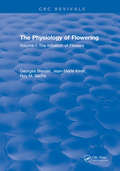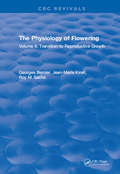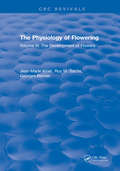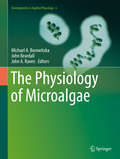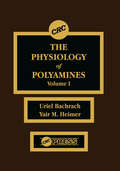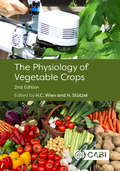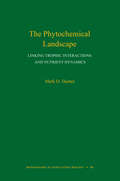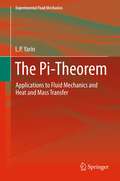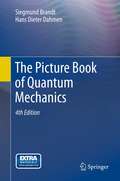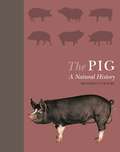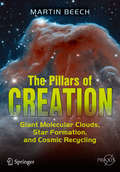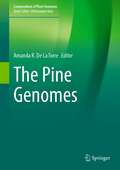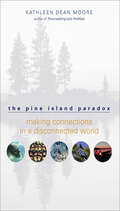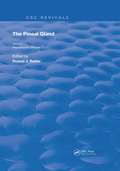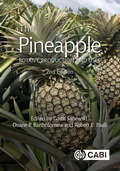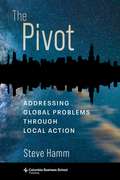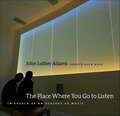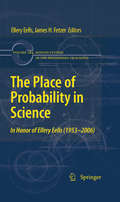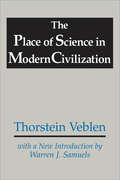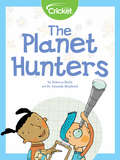- Table View
- List View
The Physiology of Flowering: Volume I: Initiation Of Flowers
by BernierThe present work is organised such that the whole phenomenon of flowing is divided into two major steps: 1. the initiation of flower primordia and 2. The development of these primordia into mature flowers until anthesis.
The Physiology of Flowering: Volume II: Transition to Reproductive Growth
by Jean-Marie Kinet Georges Bernier Roy M. SachsThe present work is organised such that the whole phenomenon of flowing is divided into two major steps: 1. the initiation of flower primordia and 2. The development of these primordia into mature flowers until anthesis.
The Physiology of Flowering: Volume III: The Development of Flowers
by Jean-Marie KinetThe present work is organised such that the whole phenomenon of flowing is divided into two major steps: 1. the initiation of flower primordia and 2. The development of these primordia into mature flowers until anthesis. With this volume aiming to to provide a balanced account of themost important and recent contributions in all aspects of the subject.
The Physiology of Microalgae
by John Beardall Michael A. Borowitzka John A. RavenThis book covers the state-of-the-art of microalgae physiology and biochemistry (and the several -omics). It serves as a key reference work for those working with microalgae, whether in the lab, the field, or for commercial applications. It is aimed at new entrants into the field (i. e. PhD students) as well as experienced practitioners. It has been over 40 years since the publication of a book on algal physiology. Apart from reviews and chapters no other comprehensive book on this topic has been published. Research on microalgae has expanded enormously since then, as has the commercial exploitation of microalgae. This volume thoroughly deals with the most critical physiological and biochemical processes governing algal growth and production.
The Physiology of Polyamines, Volume I
by Uriel Bachrach Yair M. HeimerThe area of polyamines is presented in this useful, two-volume publication. Basic information describing the role of polyamines in the processes of growth and differentiation is given. Also included are data on the regulation of polyamine biosynthesis and metabolism and their interactions with nucleic acids. Several chapters are devoted to the role of polyamines in various aspects of plant biology, with a special emphasis on their participation in the response of plants to extreme environments. Special attention is given to the use of inhibitors of polyamine biosynthesis as potential antitumor and antiproliferative agents. Additionally, progress in the molecular biology and genetic engineering of genes coding for polyamine biosynthetic enzymes is described. Cancer researchers, biologists, geneticists, biochemists, physiologists, and clinicians will find this volume indispensable.
The Physiology of Vegetable Crops
by Fred Muehlbauer Jim Giovannoni Ep Heuvelink A G Taylor Franziska S. Hanschen Susanne Neugart Monika Schreiner Martine Dorais T W Chen P J Davies H Dodson-Swenson Professor Daniel Drost I L Goldman S K Gupta K E Jaeger R Kamenetsky Goldstein Daniel Leskovar R C Okello Mary Peet Haim Rabinowitch I M Rao C Rosen S Shuler E F Souza W F Tracy P A Wigge H YasuorCompletely updated and revised, this bestselling book continues to explain the growth and developmental processes involved in the formation of vegetables. Since the publication of the successful first edition significant discoveries, particularly in the area of molecular biology, have deepened and broadened our knowledge and understanding of these processes. This new edition brings the topic up-to-date and is presented over two sections: the first provides general knowledge on germination, transplanting, flowering, the effects of stress and modelling, whilst the second section details the physiology of specific crops or crop groups. The second edition of The Physiology of Vegetable Crops: · contains two new chapters looking at stress effects on vegetable crops with a particular emphasis on climate change and models of vegetable growth and development · is fully updated to reflect recent discoveries and the advent of new production techniques such as growing in artificial environments · provides enhanced understanding of the growth and function of 18 different vegetable crops · is heavily illustrated and published in full colour throughout With contributions from renowned international experts, this is an essential resource for horticultural researchers and extension educators and consultants, as well as a reference for students and researchers in vegetable production, plant breeding, entomology and plant pathology.
The Phytochemical Landscape: Linking Trophic Interactions and Nutrient Dynamics
by Mark D. HunterThe dazzling variation in plant chemistry is a primary mediator of trophic interactions, including herbivory, predation, parasitism, and disease. At the same time, such interactions feed back to influence spatial and temporal variation in the chemistry of plants. In this book, Mark Hunter provides a novel approach to linking the trophic interactions of organisms with the cycling of nutrients in ecosystems.Hunter introduces the concept of the "phytochemical landscape"--the shifting spatial and temporal mosaic of plant chemistry that serves as the nexus between trophic interactions and nutrient dynamics. He shows how plant chemistry is both a cause and consequence of trophic interactions, and how it also mediates ecosystem processes such as nutrient cycling. Nutrients and organic molecules in plant tissues affect decomposition rates and the fluxes of elements such as carbon, nitrogen, and phosphorus. The availability of these same nutrients influences the chemistry of cells and tissues that plants produce. In combination, these feedback routes generate pathways by which trophic interactions influence nutrient dynamics and vice versa, mediated through plant chemistry. Hunter provides evidence from terrestrial and aquatic systems for each of these pathways, and describes how a focus on the phytochemical landscape enables us to better understand and manage the ecosystems in which we live.Essential reading for students and researchers alike, this book offers an integrated approach to population-, community-, and ecosystem-level ecological processes.
The Pi-Theorem
by L. P. YarinThis volume presents applications of the Pi-Theorem to fluid mechanics and heat and mass transfer. The Pi-theorem yields a physical motivation behind many flow processes and therefore it constitutes a valuable tool for the intelligent planning of experiments in fluids. After a short introduction to the underlying differential equations and their treatments, the author presents many novel approaches how to use the Pi-theorem to understand fluid mechanical issues. The book is a great value to the fluid mechanics community, as it cuts across many subdisciplines of experimental fluid mechanics.
The Picture Book of Quantum Mechanics
by Hans Dieter Dahmen Siegmund BrandtThe aim of this book is to explain the basic concepts and phenomena of quantum mechanics by means of visualization. Computer-generated illustrations in color are used extensively throughout the text, helping to establish the relation between quantum mechanics--wave functions, interference, atomic structure, and so forth--and classical physics--point mechanics, statistical mechanics, and wave optics. Even more important, by studying the pictures in parallel with the text, readers develop an intuition for such notoriously abstract phenomena as the tunnel effect excitation and decay of metastable states wave-packet motion within a well systems of distinguishable and indistinguishable particles free wave packets and scattering in 3 dimensions angular-momentum decomposition stationary bound states in various 3-dimensional potentials hybrid states Kepler motion of wave packets in the Coulomb field spin and magnetic resonance Illustrations from experiments in a variety of fields, including chemistry, and molecular, atomic, nuclear, and particle physics, underline the basic as well as the practical importance of quantum mechanics. In the present, fourth edition all computer graphics are presented in full color. It also contains additional physics topics such as hybridization. Praise for Previous Editions "The book is highly recommended as a complement to any standard textbook in quantum mechanics, but it will also be valuable to all of us who studied quantum mechanics without the pictures." -- International Journal of Quantum Chemistry "This book would be an excellent basis for the study of special topics in a quantum physics course. Most serious students of physics and all of their teachers will want to consider having this orderly and graphic outline of introductory quantum theory at their fingertips." -- American Journal of Physics "Their aim is the presentation of the 'principal ideas of wave mechanics' in such a way that students can build a quantum intuition out of their graphics." -- Scientific American "This is a unique book. It does not provide a complete course in quantum theory, but as a companion work of reference it should be quite useful to students in providing insights into the dynamical structure of the theory." -- Nature
The Pig: A Natural History
by Richard LutwycheA comprehensive, richly illustrated introduction to the fascinating natural history of the pig, from prehistory to the present At any given time, there are around one billion pigs in the world; that's one for every seven of us. And where would we be without them? Prolific, ubiquitous, smart, adaptable, and providers of high-quality protein, pigs have been our companions since neolithic times, when they obligingly domesticated themselves, coming in from the wild to root around our waste pits. But it's not all about the bacon; today, bred in micro sizes, the resourceful pig has developed a whole new career as a popular pet. And thanks to genome mapping, we now know that the pig shares many common physiological features with humans, spurring the use of pig tissue and organs in medical research and surgery. Beautifully designed and illustrated, The Pig provides a snout-to-tail natural history of this important species, from the prehistoric "hell pig" to today's placid porker, covering the pig's evolution and domestication, anatomy and biology, behavior, role in human life and culture, and breeds. The book also features an engrossing and visually stunning photographic gallery of some thirty popular breeds from around the world, with essential information about each. Filled with surprising facts and insights, The Pig will delight anyone who loves these animals and wants to understand them better. Provides a comprehensive, richly illustrated introduction to the pig's evolution and domestication, anatomy and biology, behavior, role in human life and culture, and breeds. Features infographics, diagrams, and 250 stunning color photographs. Includes a beautiful photographic directory to some 30 popular breeds from around the world, with essential information about each
The Pillars of Creation
by Martin BeechThis book explores the mechanics of star formation, the process by which matter pulls together and creates new structures. Written for science enthusiasts, the author presents an accessible explanation of how stars are born from the interstellar medium and giant molecular clouds. Stars produce the chemicals that lead to life, and it is they that have enabled the conditions for planets to form and life to emerge. Although the Big Bang provided the spark of initiation, the primordial universe that it sired was born hopelessly sterile. It is only through the continued recycling of the interstellar medium, star formation, and stellar evolution that the universe has been animated beyond a chaotic mess of elementary atomic particles, radiation, dark matter, dark energy, and expanding spacetime. Using the Milky Way and the Eagle Nebula in particular as case studies, Beech follows every step of this amazing process.
The Pine Genomes (Compendium of Plant Genomes)
by Amanda R. De La TorreThis book is the first comprehensive compilation of the most up-to-date research in the genomics, transcriptomics, and breeding of pine species across Europe, North America, and Australia. With chapters on the state of the reference genomes, transposon function, genome-wide diversity, functional genomics, genomics of disease resistance, genomics of abiotic stress, and genomic selection, this book is a must-read for scientists, breeders, and students of plant genomics. The book contains 12 chapters over 300 pages authored by a group of world-renowned scientists in the field of pine genomics. Pines (Pinus) are the world’s most economically important forest tree species. The recent genome sequencing of several important pine species has paved the way for understanding their complex biology and helps future management and breeding efforts.
The Pine Island Paradox: Making Connections in a Disconnected World (The\world As Home Ser.)
by Kathleen Dean MooreCan the love reserved for family and friends be extended to a place? “Luminous essays” on nature and environmental stewardship (Booklist).Named one of the Top Ten Northwest Books of the Year by the OregonianIn this book, acclaimed author Kathleen Dean Moore, a winner of the Sigurd Olson Nature Writing Award for Holdfast, reflects on how deeply the environment is entrenched in the human spirit, despite the notion that nature and humans are somehow separate. Moore’s essays, deeply felt and often funny, make connections in what can appear to be a disconnected world. Written in parable form, her stories of family and friends—of wilderness excursions with her husband and children, camping trips with students, blowing up a dam, her daughter’s arrest for protesting the war in Iraq—affirm an impulse of caring that belies the abstract division of humans from nature, of the sacred from the mundane. Underlying these wonderfully engaging stories is the author’s belief in a new ecological ethic of care, one that expands the idea of community to include the environment, and embraces the land as family.“Stands with the best tradition of nature writing.” —The Oregonian
The Pineal Gland: Volume 2 Reproductive Effects (Routledge Revivals #277)
by Russel J. ReiterFirst published in 1981: This volume talks about new research understandings of the function of the Pineal Gland which was thought to have no legitimate function.
The Pineapple: Botany, Production and Uses
by Robert E Paull Dr Garth M Sanewski Duane Bartholomew J. R. Botella C. C. Chen G. Coppens D’Eeckenbrugge S. A. Assis A. P. Matos E. H. Souza F. V. Souza M-F. Duval S. Hamill J. V. Jiménez D. T. Junghans H-L. Ko F. Leal J. M. Marconcini T. Padua R. E. Paull D. H. Reinhardt G. M. Sanewski A. R. Neto B. Sipes A. SolerCompletely updated with new content and full-colour figures throughout, the second edition of this successful book continues to provide a comprehensive coverage of pineapple breeding, production and yield. Pineapple is an increasingly important crop and demand for fresh pineapple is steadily growing; stakeholders in the value chain are worldwide. The Pineapple: Botany, Production and Uses provides essential coverage from botany through to postharvest handling and provides the technical information required by all those working with the crop. The second edition: - Contains new chapters on organic production and production for other uses (fibre and ornamentals). - Includes major updates to content on taxonomy, biotechnology, cultural systems, nutrition, varieties and genetic improvement. - Explores physiological changes associated with the year-round growing of pineapple in addition to the associated cultural practices and mineral nutrition. - Considers the impacts of climate change and environmental issues on pineapple crops, and relevant mitigation strategies. - Looks at the effects of new cultivars and technologies on cultural practices and plant nutrition. Written by an international team of experts, this book is an essential resource for researchers, growers and all those involved in the pineapple industry.
The Pineapple: Botany, Production and Uses (Botany, Production and Uses)
by Duane Bartholomew J. R. Botella C. C. Chen G. Coppens D’Eeckenbrugge S. A. Assis A. P. Matos E. H. Souza F. V. Souza M-F. Duval S. Hamill J. V. Jiménez D. T. Junghans H-L. Ko F. Leal J. M. Marconcini T. Padua R. E. Paull D. H. Reinhardt G. M. Sanewski A. R. Neto B. Sipes A. SolerCompletely updated with new content and full-colour figures throughout, the second edition of this successful book continues to provide a comprehensive coverage of pineapple breeding, production and yield. Pineapple is an increasingly important crop and demand for fresh pineapple is steadily growing; stakeholders in the value chain are worldwide. The Pineapple: Botany, Production and Uses provides essential coverage from botany through to postharvest handling and provides the technical information required by all those working with the crop. The second edition: - Contains new chapters on organic production and production for other uses (fibre and ornamentals). - Includes major updates to content on taxonomy, biotechnology, cultural systems, nutrition, varieties and genetic improvement. - Explores physiological changes associated with the year-round growing of pineapple in addition to the associated cultural practices and mineral nutrition. - Considers the impacts of climate change and environmental issues on pineapple crops, and relevant mitigation strategies. - Looks at the effects of new cultivars and technologies on cultural practices and plant nutrition. Written by an international team of experts, this book is an essential resource for researchers, growers and all those involved in the pineapple industry.
The Pirates of Shan (Rick Brant, # #13)
by John BlaineTwo Spindrift scientists are kidnapped from their work in the Philippine Islands. With the help of Dr. Zircon and a Hindu boy, Rick and Scotty try to find and rescue them. They learn that the ancient Pirates of Shan are still active and trace them to their stronghold to find the scientists.
The Pivot: Addressing Global Problems Through Local Action
by Steve HammWhen the world reemerges from the COVID-19 pandemic, it seems likely that it will have transformed irrevocably. Can societies already reeling from climate change, income inequality, and structural racism change for the better? Does the shock of the pandemic offer an opportunity to pivot to a more sustainable way of life?Early in the crisis, a global volunteer collaboration called Pivot Projects was formed to rethink how the world works. Some members are experts in the sciences and the humanities; others are environmental activists or regular people who see themselves as world citizens. In The Pivot, the journalist Steve Hamm—who embedded in the enterprise from the start—explores their efforts and shows how their approach provides a model for achieving systemic change. Chronicling the group’s progress along an uncharted path, he shows how people with a variety of skills and personalities collaborate to get things done. Through their work, Hamm examines some of today’s most important technologies and concepts, such as systems thinking and modeling, complexity theory, artificial intelligence, and new thinking about resilience. The book features vivid, informal profiles of a number of the group’s members and brings to life the excitement and energy of dynamic, smart people trying to change the world.Part journal of a plague year and part call to action, The Pivot tells the remarkable story of a collaborative experiment seeking to make the world more sustainable and resilient.
The Place Where You Go to Listen: In Search of an Ecology of Music
by John Luther AdamsDid Alaska create the music of John Luther Adams, or did the music create his Alaska? For the past thirty years, the vastness of Alaska has swept through the distant reaches of the composer's imagination and every corner of his compositions. In this new book Adams proposes an ideal of musical ecology, the philosophical foundation on which his largest, most complex musical work is based. This installation, also called The Place Where You Go to Listen, is a sound and light environment that gives voice to the cycles of sunlight and darkness, the phases of the moon, the seismic rhythms of the earth, and the dance of the aurora borealis. Adams describes this work as "a place for hearing the unheard music of the world around us." The book includes two seminal essays, the composer's journal telling the story of the day-to-day emergence of The Place, as well as musical notations, graphs and illustrations of geophysical phenomena.
The Place of Probability in Science
by Ellery Eells J. H. FetzerThe purpose of philosophy, broadly conceived, can be described as that of attempting to resolve heretofore unsolved conceptual and theoretical problems, especially those that lie at the foundations of knowledge and values. Given the central role of science in acquiring reliable knowledge, the study of science has become of special importance within philosophy. And within philosophy of science, in turn, no other concept possesses the centrality and importance as does that of probability. To clarify and illuminate the place of probability in science Ellery Eells and James H. Fetzer have brought together some of the most distinguished philosophers from our time. After a comprehensive introduction to alternative conceptions of objective probability and the difficulties that they confront, three studies describe the special problems that arise within this context and the comparative merits of different accounts. The second section addresses the nature of lawfulness and of relations between micro- and macro-probabilities, especially with reference to the concept of fitness in evolution. The third section confronts some of the difficulties confronted by causal conceptions of probability, especially within the quantum domain. The fourth extends the discussion to principles of inference and decision. The last chapter relates propensities and frequencies to the framework of inference to the best explanation.
The Place of Science in Modern Civilization: And Other Essays (1919)
by Thorstein VeblenOn its original publication in 1919, The Place of Science in Modern Civilization was recognized as a major contribution, and today Veblen continues to command attention and respect. This volume includes some of his most seminal work, essays that have critical, almost devastating implications for capitalist society and mainstream economic theory as well as Marxism and socialism in general.The continuing power of Veblen's work derives both from the penetration and range of his analysis and the arguable failure of modern society and social science theory to change in any material respect since he worked. The continuing relevance of his topics and ideas is manifest. In this volume in particular, Veblen addresses controversies over the relations of deduction and induction and efforts to produce truth, belief systems, and language, disputes about the significance of business mergers and acquisitions, and questions about the historical meaning and status of socialism. All of these are subjects of continuing interest and concern.The first six essays are fundamental contributions to the study of the preconceptions that drive thought and modern science and their origins. The next nine essays apply Veblen's thinking to critiques of other economists and capitalism. Three of these nine essays represent fundamental components of Veblen's view of capitalism and its problems are of lasting interpretive and analytic value. The final three essays in the book, and in particular the last two, are examples of a genre of thinking which, while not uncommon among social scientists of the period in which Veblen worked haven been discredited and certainly have no lasting value, being conjectural history using such concepts as natural selection.As Warren Samuels notes in his stimulating introduction to this new edition, "Veblen was heterodox, iconoclastic, sardonic, caustic, and satiric. He also was brilliant, penetrating, original, courageous, literarily dram
The Placenta and Human Developmental Programming
by Graham J. Burton David J. P. Barker Ashley Moffett Kent ThornburgDevelopmental programming is a rapidly advancing discipline of great importance to basic scientists and health professionals alike. This text integrates, for the first time, contributions from world experts to explore the role of the placenta in developmental programming. The book considers the materno-fetal supply line, and how perturbations of placental development impact on its functional capacity. Chapters examine ways in which environmental, immunological and vascular insults regulate expression of conventional and imprinted genes, along with their impact on placental shape and size, transport, metabolism and endocrine function. Research in animal models is integrated with human clinical and epidemiological data, and questions for future research are identified. Transcripts of discussions between the authors allow readers to engage with controversial issues. Essential reading for researchers in placental biology and developmental programming, as well as specialists and trainees in the wider field of reproductive medicine.
The Planet Earth and The Universe (Planet Guides)
by Duncan BrewerThis short yet informative book discusses the Big Bang Theory, and how the planets were formed, as well as the debates of ancient astronomers whether the earth was the center of the Universe or if the sun was. Informative facts about the Earth as a planet, and interesting facts about its moon. Worth reading if interested in fundamental astronomy or the planets. Great for all ages. Scientific terms are defined in the text and in a glossary. Picture captions give meat to the story.
The Planet Gods: Myths and Facts about the Solar System
by Jacqueline Mitton; Christina BalitThough many of the planets were named long before we had good scientific information about them, Mitton draws readers attention to some amazing coincidences. The veiled goddess Venus lends her name to a cloud-shrouded planet. The blue, stormy planet Neptune is named for the god of the sea.
The Planet Hunters
by Rebecca BoyleOne way astronomers search for planets is by looking for the shadows they cast in front of stars.
